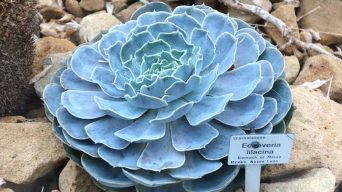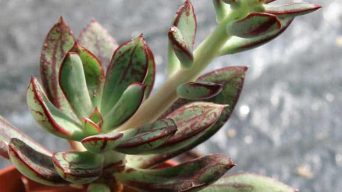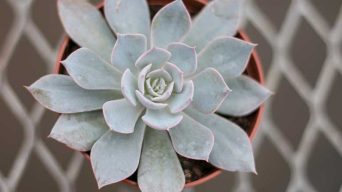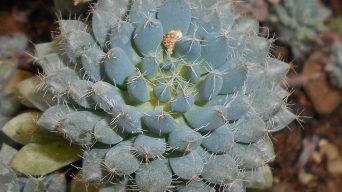Succulents are fascinating, attractive plants that have been popular for many years.
Many people have fallen in love with succulents because of their lovely flowers and their tough nature.
One specific type of succulent is the Echeveria setosa ‘Mexican Firecracker’ – a beautiful flowering succulent with gorgeous red blooms and delicate foliage.
This article will teach you everything you need to know about caring for and propagating Echeveria setosa, the Mexican Firecracker Echeveria.
Overview
Echeveria setosa, also known as the Mexican firecracker, is a flowering plant in the Crassulaceae family that is native to semi-arid regions of Mexico.
Echeveria setosa is an evergreen succulent with short stems and rosettes that has silvery-white hairs covering its leaves and giving it a soft texture and glimmering sheen.
The rosettes are typically 4.8 inches (12 cm) in diameter, with fleshy spoon-shaped leaves growing up to 2.8 inches (7 cm) long and 0.8 inches (2 cm) broad.
It blooms in spring and summer as bright red and yellow flowers stand erect on long stems that emerge from their rosettes.
The flowers form cymes up to 20 cm in diameter, growing as much as 2 cm per day until full bloom.
How To Care for Echeveria Setosa ‘Mexican ‘Firecracker’
Echeveria setosa care is pretty straightforward, as it doesn’t need a lot of attention.
It’s an excellent succulent for beginners and perfect for those who have a green thumb.
Below you’ll find the essential information you need to know about caring for Echeveria setosa.
Sun Exposure & Light Requirements
Echeveria setosa ‘Mexican Firecracker’ is a succulent plant that requires bright light conditions during the day to prosper and stay healthy.
This plant species will display its best colors when exposed to plenty of sunlight, but it can survive in partial shade if necessary.
While this species may be a bit more tolerant to low light conditions than some other succulent plants, it will still need at least 4 hours of direct sunlight each day.
When grown indoors, place your Echeveria setosa in a sunny window sill where it can receive plenty of natural sunlight throughout the day. A west-facing or east-facing window will be a good choice.
The Mexican Firecracker is a great plant for warm, sunny areas that receive plenty of bright sunlight if grown outdoors.
This succulent plant can also be grown in warmer climates with low humidity and moderate rainfall.
In addition to receiving direct sunlight, your Echeveria setosa mustn’t be exposed to the extremely hot sun during the middle of the day.
This species does not tolerate excessive heat very well, so it’s best to avoid placing these plants in areas with consistent afternoon sun.
Watering Requirements
As with all succulents, it is always best to err on the side of underwatering. This is because Echeverias are prone to root rot if they are overwatered.
It is best to water them thoroughly and allow their soil to dry out completely before the next watering.
How often should you water an Echeveria depends on many factors, including the pot size, time of year, and weather conditions.
A good guide from personal experience is to water when 1/3 to 1/2 of the soil has dried out.
Echeverias require more frequent watering in hotter summer months, and in cooler winter months, water less often.
This succulent should only be watered when the soil is dry. Check the soil’s moisture level with your finger. If it is still moist, let it dry out first.
Soil Requirements
Echeveria setosa succulents require a well-draining potting mix, using plenty of sand and grit to ensure the soil drains quickly.
These plants are very susceptible to root rot if they do not have appropriate drainage or overwatering is allowed.
A cactus and succulent soil mix are great for growing Echeveria setosa succulents.
If you can’t find soil that suits your needs, try mixing three parts potting soil, two parts coarse sand or gravel, and one part perlite.
This mixture will give your Echeveria setosa plenty of drainage.
Temperature and Humidity
Echeveria setosa thrives in warm temperatures, it should be kept at a temperature of around 65-75° Fahrenheit during the day and 50-55° Fahrenheit at night.
It should be kept out of drafts and should not be exposed to temperatures that reach the lower or higher sixties or seventies, as this will cause discoloring of the leaves.
The Mexican Firecracker will need less humidity than most other succulents.
It’s well-adapted to living in an arid environment, so you should keep it dry when the top inch of soil becomes dry to the touch and maintain a slightly lower than average humidity.
Fertilizing
Echeveria setosa ‘Mexican Firecracker’ Echeverias are somewhat sensitive to fertilizer, and too much is usually not a good thing.
An overdose of fertilizer can burn your Echeveria and possibly kill it.
If you want to fertilize, use a balanced liquid fertilizer diluted to half-strength once every two weeks during the growing season.
Do not fertilize Echeverias during their winter dormancy.
Potting and Repotting
Echeveria setosa plants can be repotted at any time in spring or summer, but autumn and winter are not the best times to repot them.
Be sure to choose a pot that is about two inches larger than the one they currently occupy. The best pot type for this plant is a shallow container with good drainage holes.
Terracotta and unglazed pots are the best containers for Echeveria because they drain water very well.
You should avoid using a plastic pot, which can trap moisture and cause root rot.
A good tip is to place several inches of gravel or crushed rock at the bottom of the pot before you place your Echeveria inside. This will allow for better drainage.
Pruning
Echeveria setosa succulents don’t require extensive pruning, but you can prune it when necessary. There are two types of pruning, soft pruning, and hard pruning.
Soft pruning is when you remove the dead flowers or leaves. This prevents rot or diseases or when they become leggy and elongated due to lack of sunlight.
Hard pruning removes stems to decrease in size, slow growth, or prevent the Echeveria from becoming leggy.
This is an effective method for Echeverias if they become too large and unruly for a container garden.
When you need to prune your Echeveria setosa, do so early in the morning so that it can be sure to seal all its cuts off from the environment.
Using a clean, sharp pair of scissors or pruners is sufficient for most cases.
If you see rot in the center of your Echeveria setosa plant, you can cut it back to just above, where there isn’t any sign of mold or fungus already.
Ensure it has enough sunlight after this, or try putting it in a slightly shadier spot.
Pruning will encourage the Echeveria to produce more stems, so don’t prune it frequently if you are looking for an Echeveria with less growth.
Pests and Diseases
Echeveria setosa is generally pest-free, but a few pests and diseases could be potentially problematic.
Fortunately, these pests and diseases are often easy to identify and manage.
Rot
Rot is a fairly common issue with Echeveria plants. However, it typically only occurs in Echeveria when they’ve been overwatered — typically due to over-zealous watering or a soil that holds too much water.
In plants with normal, healthy roots, the rot will manifest as brownish-red to black patches on the leaves or stem of the plant.
In plants where the rot has progressed enough, it can potentially kill the entire plant.
To help prevent rot, ensure your Echeveria setosa gets plenty of sunshine and water but not overwater.
Make sure the soil dries out in between watering. If you suspect your plant has root rot, repot with a good cactus or succulent soil mix.
Powdery Mildew
Another common issue is the presence of powdery mildew on Echeveria setosa plants.
If you notice that your leaves are developing white patches, chances are very good that your plant has powdery mildew.
Sometimes, the powdery mildew may look like the plant has been dusted with flour.
To treat this powdery mildew, use a neem oil-based fungicide.
Spray the plant down (do not ingest or otherwise get the fungicide on any part of your body), and the plant should recover within about two weeks.
Mealybugs
Mealybugs are another common pest on Echeveria setosa and can be a significant problem.
They look like white, cottony patches on the leaves and stem of your plant, and they’re generally easiest to identify by the honeydew they leave behind.
Like powdery mildew, these mealybugs can often kill entire plants if not treated quickly.
To treat your Mexican Firecracker for mealybugs, use a cotton swab to dab on some neem oil or isopropyl alcohol.
These two liquids will remove the mealybugs from your plant and help with future prevention.
Vine Weevil
Vine weevils aren’t as common as other pests, but they can be problematic for Echeveria setosa.
In most cases, the best way to manage vine weevil is to remove the affected plant from the area and dispose of it, preventing further infestation.
You can also use diatomaceous earth to treat your Mexican Firecracker for vine weevil.
Diatomaceous earth is a powdery sediment that can help control and kill ringworms, earwigs, roaches, ants, and other pests.
To use diatomaceous earth on your Echeveria setosa plant (and any plants you want to protect), sprinkle the diatomaceous earth over the surface of the soil (not touching or otherwise getting on any part of your plant).
If you sprinkle it around the base of your Mexican Firecracker, this will help prevent future infestations.
How to Care for Echeveria Setosa ‘Mexican ‘Firecracker’ in Winter
Echeveria setosa ‘Mexican ‘Firecracker’ is not cold hardy and can’t tolerate temperatures below freezing, so it’s essential to be vigilant about preventing the plant from getting too cold.
If you live in an area where temperatures get below freezing for an extended period during the winter, consider bringing your ‘Mexican Firecraker’ inside so it doesn’t freeze.
Doing this is especially recommended if you have slow-growing Echeveria setosa since the plant won’t produce new leaves to keep itself alive.
Keep in mind that the plant won’t survive indoors if it doesn’t get enough sunlight, so locate your Echeveria ‘Mexican Firecracker’ in a bright location but out of the direct sun.
Also, reduce water in the winter when it’s cold out since the plant’s leaves will be more susceptible to rotting.
If you live in an area where the temperature rarely drops below freezing, you may be able to leave your ‘Mexican Firecracker’ planted outside all winter.
Cold weather isn’t the only threat to Echeveria setosa ‘Mexican Firecracker’.
The plant won’t tolerate freezing winds or dry air, so protect it from these factors by planting it near a wall where it can get some protection.
As temperatures rise during spring, you can start turning up the water and light. Increase your plant’s sun exposure and water levels throughout springtime.
You can move your Echeveria ‘Mexican Firecracker’ back outside when the last frost has passed in your area.
How To Propagate Echeveria Setosa ‘Mexican ‘Firecracker’
The Echeveria setosa ‘Mexican ‘Firecracker’ can be propagated by leaves, stem cuttings, or offsets.
Propagating Echeveria Setosa ‘Mexican ‘Firecracker’ With Leaves
Echeveria setosa ‘Mexican ‘Firecracker’ can be propagated by leaf cuttings.
To propagate Echeveria setosa ‘Mexican ‘Firecracker’ with leaves:
- Remove the leaf from the mother plant
- Allow it to callous for a few days or more before laying it on top of well-draining soil.
- Keep the soil moist until it roots.
- Once rooted, plant the leaf in a new pot with well-draining soil.
Propagating Echeveria Setosa ‘Mexican ‘Firecracker’ With Offsets
Echeveria setosa ‘Mexican ‘Firecracker’ can be propagated by removing offsets from the mother plant and replanting them in a new well-draining pot.
Offsets are the small rosettes that grow next to the mother rosette and can be removed by gently pulling them away from the mother rosette.
To propagate Echeveria setosa ‘Mexican ‘Firecracker’:
- Gently pull the small rosette away from the mother rosette to remove it.
- Do not use scissors or shears, which may damage the mother rosette.
- Allow the offset to callous for a few days and plant it in a new pot with well-draining soil.
- Water only when the soil is dry, and keep the plant in a bright location.
Propagating Echeveria Setosa ‘Mexican ‘Firecracker’ With Stem Cuttings
Echeveria setosa ‘Mexican ‘Firecracker’ can also be propagated by stem cuttings.
To propagate Echeveria setosa ‘Mexican ‘Firecracker’ with stem cuttings:
- Cut a piece of stem from the mother plant using sanitized shears or scissors.
- Allow the piece of the stem to callous for a few days.
- Plant the stem in a new well-draining pot and keep the soil moist until new growth appears.
- Water only when the soil is dry and place it under bright indirect light.
Final Thoughts
Growing succulents like Echeveria setosa ‘Mexican Firecracker’ is easy.
The best part about this type of plant is that it can be grown indoors or outdoors, depending on the climate you live in.
They are very low-maintenance plants requiring only sunlight, minimum water, and good well-draining soil.
If you are a beginner with succulents, I suggest starting with this variety, as it is one of the easiest to grow.







